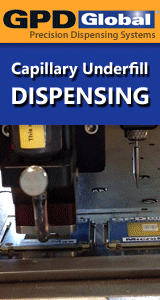Comparison of ROSE, C3/IC, and SIR as an effective cleanliness verification test for post soldered PCBA
Published: |
April 17, 2023 |
Author: |
Kong Hui Lee, Rob Jukna, Jim Altpeter, Kantesh Doss |
Abstract: |
The purpose of this paper is to evaluate and compare the effectiveness and sensitivity of different cleanliness verification tests for post soldered printed circuit board assemblies (PCBAs) to provide an understanding of current industry practice for ionic contamination detection limits. Design/methodology/approach – PCBAs were subjected to different flux residue cleaning dwell times and cleanliness levels were verified with resistivity of solvent extract, critical cleanliness control (C3) test, and ion chromatography analyses to provide results capable of differentiating different sensitivity levels for each test. Findings – This study provides an understanding of current industry practice for ionic contamination detection using verification tests with different detection sensitivity levels. Some of the available cleanliness monitoring systems, particularly at critical areas of circuitry that are prone to product failure and residue entrapment, may have been overlooked. Research limitations/implications – Only Sn/Pb, clean type flux residue was evaluated. Thus, the current study was not an all encompassing project that is representative of other chemistry-based flux residues. Practical implications – The paper provides a reference that can be used to determine the most suitable and effective verification test for the detection of ionic contamination on PCBAs. Originality/value – Flux residue-related problems have long existed in the industry. The findings presented in this paper give a basic understanding to PCBA manufacturers when they are trying to choose the most suitable and effective verification test for the detection of ionic contamination on their products. Hence, the negative impact of flux residue on the respective product's long-term reliability and performance can be minimized and monitored effectively.... |
|
|
|
Company Information:
More articles from Jabil Circuit, Inc. »
- Mar 13, 2023 - An Introduction To The Process Of Printed Electronics
- Oct 18, 2018 - Analysis of the Design Variables of Thermoforming Process on the Performance of Printed Electronic Traces
- Jan 17, 2013 - Identification and Prevention of "Black Pad"
- May 13, 2006 - Wave Solder Parameter Chart
- See all SMT / PCB technical articles from Jabil Circuit, Inc. »
More SMT / PCB assembly technical articles »
- Mar 19, 2024 - What is Underfill | GPD Global

- Mar 19, 2024 - Made in Japan: Solder Paste Jet Dispensing Machine | I.C.T ( Dongguan ICT Technology Co., Ltd. )

- Feb 26, 2024 - Precision Control in Electronic Assembly: Selective Wave Soldering Machine | I.C.T ( Dongguan ICT Technology Co., Ltd. )

- Feb 02, 2024 - Maximizing Efficiency: The High-Speed SMT Line With Laser Depanelizer | I.C.T ( Dongguan ICT Technology Co., Ltd. )

- Dec 27, 2023 - Revolutionizing Tech: SMT Auto IC Programming Machine Mastery | I.C.T ( Dongguan ICT Technology Co., Ltd. )

- Browse Technical Library »
Comparison of ROSE, C3/IC, and SIR as an effective cleanliness verification test for post soldered PCBA article has been viewed 399 times







